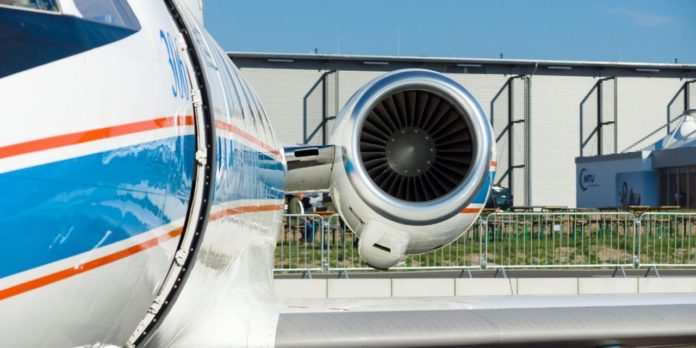Honeywell has additively manufactured a flight-critical engine part, which was installed on an in-service engine. Known as the #4/5 bearing housing, Honeywell received FAA certification for the part, achieving therefore a milestone for the entire aviation and additive manufacturing industries.
The 3D printed part is a major structural component in the ATF3-6 turbofan engine used on the Dassault Falcon 20G maritime patrol aircraft, which are used by the French Navy for patrol and search-and-rescue missions.
Designed by Garrett in the 1960s and certified in 1967, there are only about a dozen ATF3-6 engines still flying. This presents sourcing and supply chain challenges for operators of Dassault Falcon 20G aircraft. Additionally, the #4/5 bearing housing is a complicated part to manufacture — making it extremely costly for operators to replace due to the low quantity of orders placed. This challenge is combined with the high cost of tools needed to produce parts with traditional casting methods, where molten metal is poured into a mold and allowed to harden. With additive manufacturing, these parts can be printed much more quickly and in smaller quantities without the need for expensive tools. During this process, components are built from the bottom up, with layers of powdered metal fused on top of one another using a laser.
“Though there aren’t many in service, Honeywell is responsible for supporting and maintaining these engines. We had to find a way to address these supply chain issues and keep these aircraft flying,” said Jon Hobgood, vice president of manufacturing engineering, Honeywell Aerospace. “We were able to use our expertise in additive manufacturing to produce the qualified part much faster, reducing our lead time from approximately two years to two weeks.”
Parts such as the #4/5 bearing housing are considered “safety-critical” or “flight-critical” by regulatory bodies, meaning they must always function properly. Malfunction or failure of these parts would pose a major threat to passenger and crew safety and could cause significant damage to an aircraft. Safety-critical parts face increased scrutiny and must be approved by regulatory organizations like the Federal Aviation Administration (FAA) before they can be used on an aircraft, which makes the process from development to qualification a lengthy one.
Honeywell has been working closely with the FAA on the development and certification of multiple additive-manufactured components. These efforts have enabled the bearing housing to be the first component approved under the normal FAA delegated authority, further reducing the time for qualification.
“This is a major milestone for Honeywell because it demonstrates the maturity of our additive manufacturing operations and paves the way for us to print more certified, flight-critical parts in the future,” Hobgood added. “It also is a major win for the additive industry, as flight-critical parts face heavy scrutiny and high standards for qualification and installation on aircraft, but this shows it can be done.”
Production is currently underway for the #4/5 bearing housing, with dozens more of the bearing housing expected to be produced the end of 2020. Honeywell began its efforts in metal additive manufacturing in 2007 at its lab in Phoenix. Today, the company produces hundreds of different aircraft components with 3D printing and has expanded its industry-leading efforts to additional operations in China, Europe, India and the United States.
Remember, you can post AM job opportunities for free on 3D ADEPT Media or look for a job via our job board. Make sure to follow us on our social networks and subscribe to our weekly newsletter: Facebook, Twitter, LinkedIn & Instagram! If you want to be featured in the next issue of our digital magazine or if you hear a story that needs to be heard, make sure to send it to contact@3dadept.com






